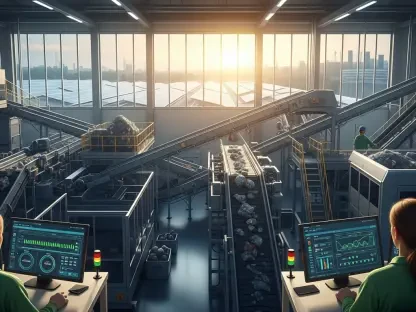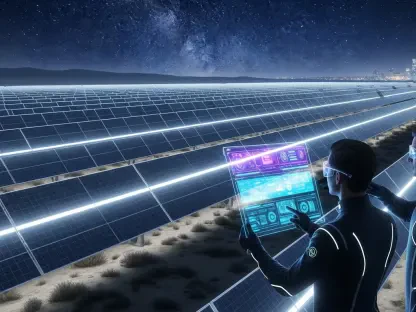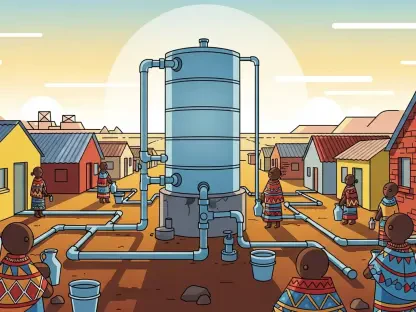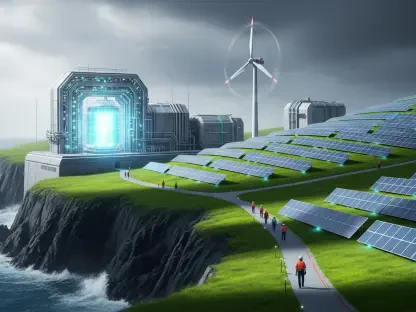Allow me to introduce Christopher Hailstone, a renowned expert in energy management, renewable energy, and electricity delivery. With his deep knowledge of grid reliability and security, Christopher offers critical insights into the intersection of climate change and national security. Today, we’ll explore Iceland’s groundbreaking stance on melting glaciers as a security threat, the potential collapse of the Atlantic Meridional Overturning Circulation (AMOC), and the broader implications for global weather patterns and climate policy. We’ll also touch on the latest developments from COP30 in Brazil and the urgent need for inclusive climate solutions. Join us for an engaging conversation that unpacks these pressing environmental challenges.
Can you explain why Iceland has identified the potential collapse of the Atlantic Meridional Overturning Circulation as a national security risk?
Absolutely, Emilia. Iceland’s decision to label the AMOC’s potential collapse as a national security risk stems from the profound impact it could have on the country’s climate, economy, and way of life. The AMOC is a critical ocean current that regulates temperatures by carrying warm water from the tropics to the North Atlantic. For a nation like Iceland, positioned in such a vulnerable northern latitude, any disruption to this system could mean drastic cooling, affecting everything from agriculture to energy needs. Their climate minister has emphasized that this isn’t just an environmental issue—it’s an existential threat that demands strategic planning at the highest level.
What specific impacts does Iceland anticipate if the AMOC were to shut down?
If the AMOC collapses, Iceland could face a dramatic drop in winter temperatures, potentially ushering in conditions reminiscent of a mini ice age. This would disrupt fishing—an economic backbone for the country—as well as impact infrastructure and heating demands in a place already grappling with harsh winters. Beyond the immediate cold, there’s also concern about rising sea levels from melting glaciers, which could threaten coastal communities. It’s a cascading set of challenges that could strain national resources and resilience.
How is Iceland preparing for these worst-case scenarios you’ve described?
Iceland is taking a proactive stance by bringing this issue before their National Security Council, which is a significant step in itself. They’re focusing on building resilience through infrastructure improvements, diversifying energy sources—already a strength with their geothermal and hydropower—and enhancing emergency response systems. There’s also a push to collaborate internationally, as this isn’t a problem they can solve alone. They’re looking at scientific data and modeling to anticipate changes and prioritize adaptive measures, ensuring they’re not caught off guard.
Is this the first time a climate issue has been framed as a security threat in Iceland, and what prompted this shift in thinking?
Yes, this is a historic move. Iceland’s climate minister noted that it’s the first time a specific climate phenomenon has been formally recognized as a potential existential threat at this level. What prompted this shift is a combination of accelerating glacier melt, alarming scientific projections about the AMOC, and the realization that climate change isn’t a distant future problem—it’s happening now. Iceland’s unique geography makes it a frontline state for these changes, forcing a reevaluation of how climate impacts national stability and security.
Can you walk us through how the AMOC influences weather patterns in Europe, particularly in places like Iceland?
Certainly. The AMOC acts like a giant conveyor belt in the Atlantic Ocean, moving warm water from the tropics northward and cold water back south. This process moderates Europe’s climate, especially in northern regions like Iceland, by keeping winters milder than they would otherwise be at such high latitudes. Without the AMOC, the heat transfer stops, and places like Iceland and Scandinavia could see winter temperatures plummet by several degrees, leading to harsher, longer cold spells that disrupt daily life and ecosystems.
What role does the melting of Arctic ice and Greenland’s ice sheet play in potentially disrupting the AMOC?
The melting of Arctic ice and Greenland’s ice sheet introduces a massive amount of cold, fresh water into the North Atlantic. The AMOC relies on a delicate balance of temperature and salinity to drive its circulation—warm, salty water sinks as it cools in the north, propelling the current. When you flood the system with fresh water, it dilutes the salinity, making it harder for the water to sink. This can slow or even stall the current, which is why scientists are so concerned about the accelerating melt rates we’re seeing.
If the AMOC collapses, how quickly might we see extreme cold winters in Northern Europe?
That’s a tough question because the timeline isn’t entirely clear—it depends on how fast the current weakens and whether we hit a tipping point. Some models suggest that significant cooling could start within a few decades if current trends continue, while others warn it could be sooner if there’s a sudden surge of meltwater. What’s certain is that once the AMOC slows past a critical threshold, the climate shift could happen relatively fast, within a decade or two, leaving little time for adaptation.
Beyond Europe, which other global regions might face challenges due to changes in the AMOC, and in what ways?
The AMOC’s influence extends far beyond Europe. A collapse could disrupt rainfall patterns in regions like West Africa, India, and parts of South America, where monsoon systems and seasonal rains are tied to ocean currents. These areas rely on predictable precipitation for agriculture, so any shift could lead to droughts or floods, threatening food security. Additionally, changes in ocean circulation could impact marine ecosystems globally, affecting fisheries that millions depend on for protein and income.
How could a collapse of the AMOC affect rainfall patterns in places like Africa, India, and South America?
The AMOC plays a role in regulating the global heat distribution, which influences atmospheric patterns like the Intertropical Convergence Zone, where much of the world’s rainfall occurs. If the AMOC weakens, it could shift or weaken these patterns, leading to reduced rainfall in regions like the Sahel in Africa or altered monsoon intensity in India. In South America, the Amazon basin might see changes in wet and dry seasons, potentially accelerating deforestation as ecosystems struggle to adapt.
What does this mean for farmers who depend on consistent weather for their livelihoods in these regions?
For subsistence farmers in these areas, a disruption in rainfall patterns could be devastating. Many lack the resources to pivot quickly—whether it’s switching crops, accessing irrigation, or relocating. Unpredictable weather could mean failed harvests, leading to food shortages, higher prices, and increased poverty. It’s not just a local issue; these disruptions ripple through global food supply chains, affecting prices and availability far beyond the impacted regions.
Are there any early warning signs or data points scientists are monitoring to predict if and when the AMOC might collapse?
Yes, scientists are closely watching several indicators. They’re monitoring the salinity and temperature of water in key North Atlantic regions to detect slowdowns in the current. Measurements of meltwater input from Greenland are also critical, as is tracking the strength of deep-water formation in the Labrador Sea. While we don’t have a definitive ‘red line’ yet, these data points help build models to estimate risk. The challenge is that natural variability can mask trends, so it’s a complex puzzle to solve.
What’s your perspective on the relatively subdued atmosphere at COP30 in Brazil, aside from the protests?
COP30 has felt quieter than past summits, partly because the global political landscape on climate action is so fragmented right now. Many countries are focused on domestic challenges—economic recovery, energy costs, or political transitions—which can dampen the urgency at international forums. There’s also a sense of fatigue after years of ambitious pledges that haven’t always translated into action. That said, the lack of headline-grabbing breakthroughs doesn’t mean progress isn’t happening behind closed doors on technical or financial agreements.
Can you share more about the key issues or demands being raised by protesters at COP30?
The protesters at COP30 are amplifying critical voices, especially from Indigenous communities and frontline groups. They’re demanding greater representation in climate negotiations, pointing out that those most affected by climate change often have the least say in solutions. There’s also frustration over insufficient funding for adaptation in vulnerable regions and calls for stronger commitments to phase out fossil fuels. Their presence is a reminder that climate justice—ensuring equity in how we address this crisis—is just as important as cutting emissions.
How do you view California Governor Gavin Newsom’s criticism of the U.S. federal government’s reversal on climate action?
Governor Newsom’s sharp critique reflects a growing divide between state and federal priorities in the U.S. He’s called the rollback of climate policies shortsighted, and I tend to agree that stepping back from global commitments undermines both environmental and economic progress. California has positioned itself as a leader in green tech and emissions reductions, so there’s a real tension when federal policy doesn’t align. It highlights how subnational actors are stepping up when national leadership falters, which is both inspiring and concerning.
What steps is California taking to maintain momentum on climate goals despite federal pushback?
California is doubling down on its own policies, investing heavily in renewable energy, electric vehicle infrastructure, and energy efficiency programs. They’re also forging partnerships with other states and international players to keep up the pace on emissions reductions. Governor Newsom has emphasized green technology as a driver of jobs and innovation, so there’s a strong economic angle to their strategy. It’s about proving that climate action can work at a state level, even if the federal government isn’t fully on board.
What is your forecast for the future stability of the AMOC, and how should global leaders prioritize this issue?
My forecast for the AMOC is cautious but not entirely pessimistic. While the risk of collapse is real—potentially within this century if warming and ice melt continue unabated—there’s still time to act if we drastically cut greenhouse gas emissions and invest in monitoring systems. Global leaders need to prioritize this as a shared security concern, not just a regional one, because the cascading effects touch every continent. It’s about integrating AMOC research into climate models, funding adaptation for vulnerable areas, and recognizing that ocean health is as critical as atmospheric carbon levels. We can’t afford to treat this as a distant threat—it’s a ticking clock that demands collective action now.









